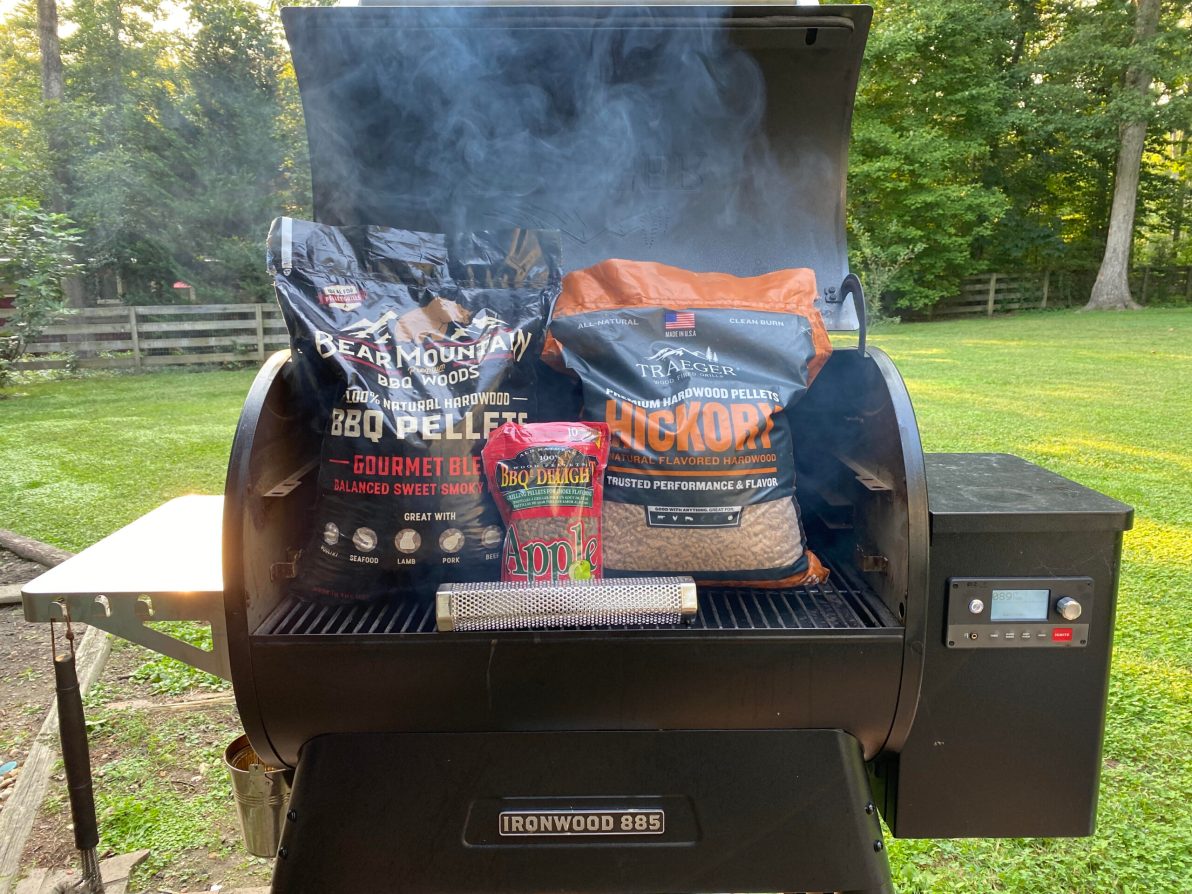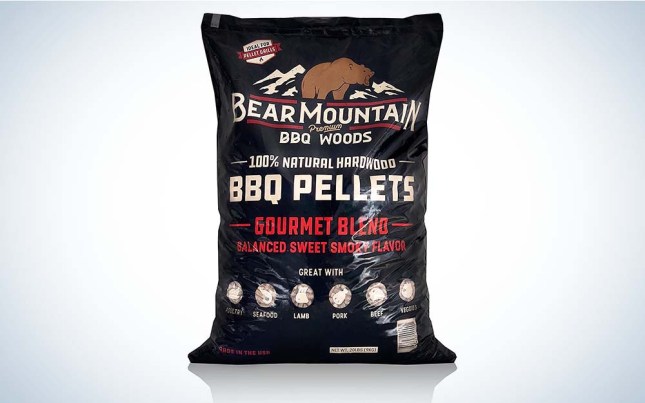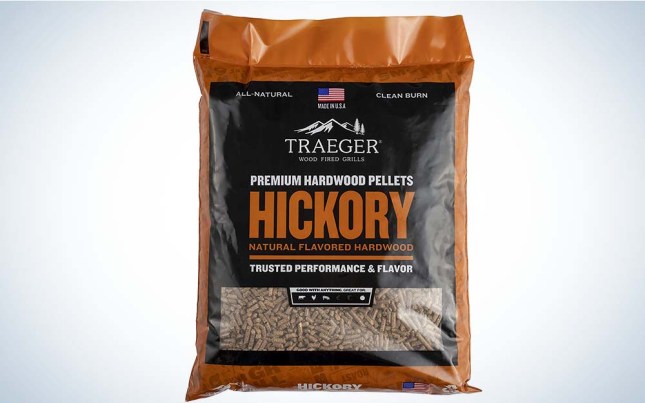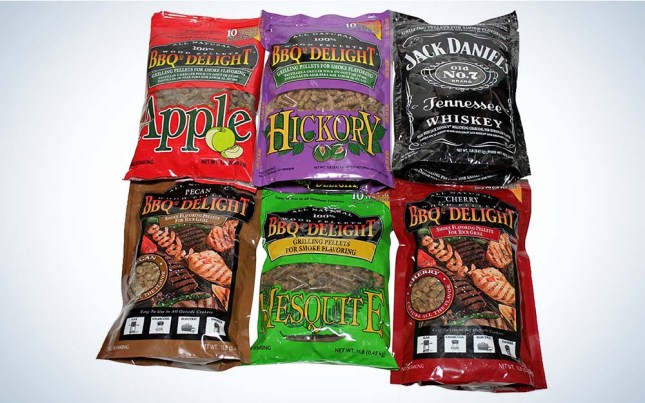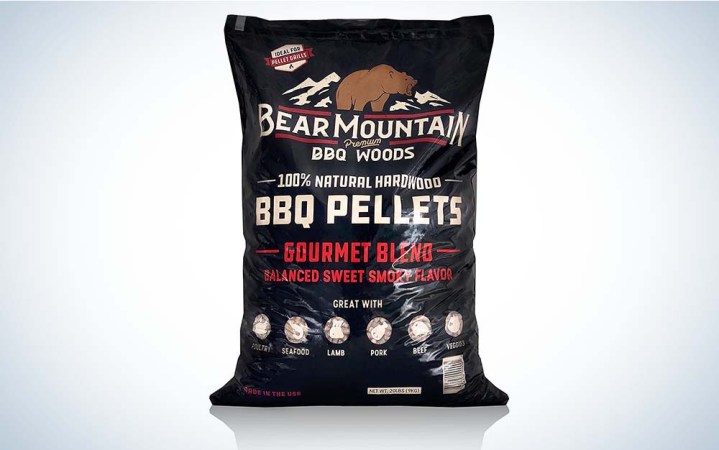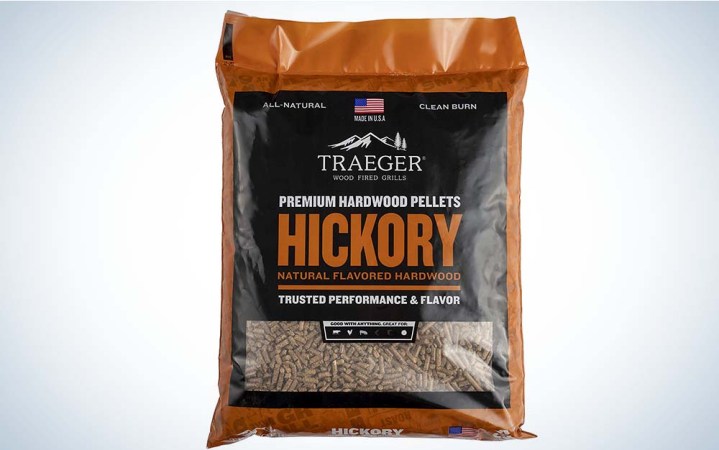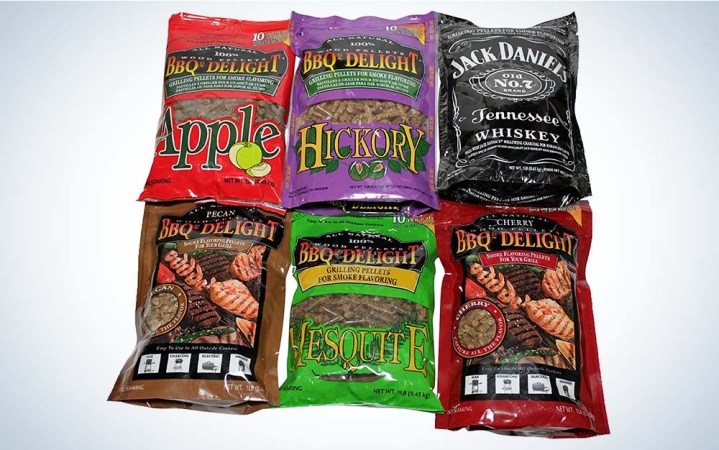We may earn revenue from the products available on this page and participate in affiliate programs. Learn More ›
Smoker pellets provide both the seasoning and the fuel for your BBQ. So, they can make or break your meal. The best wood pellets need to feed well in your pellet smoker and produce a delicious smoke flavor. I’ve made choosing the best wood pellets for your next meal a little easier by doing the hard work of smoking and eating a ton of BBQ while testing a selection of smoker pellets for both hot and cold smoking.
Our picks are all made from US-sourced, all-natural hardwood. They don’t contain binders or fake wood flavor additives, so you can rest assured you’ll get nothing but natural wood flavor. After a few hundred hours of smoking with the best smokers and many bags of wood pellets, here are the top picks.
Best Wood Pellets for Smoking: Bear Mountain All-Natural Hardwood Pellets Gourmet Blend
Key Features
- Made in the USA
- All-natural hardwood
- Available in several wood varieties
- No additives or binders
- 20- or 40-pound bags
Why It Made the Cut
The Bear Mountain pellets provide a clean burn, excellent flavor, and feed well in most pellet smoker hoppers.
Pros and Cons
Pros
- Flavor
- Variety
- Price
Cons
- Long pellet size can jam in some smoker augers.
Product Description
I tested the Bear Mountain hickory and gourmet blend pellets in my Traeger Ironwood 885 for both high-temperature grilling and low and slow smoking. The pellets provided perfect smoky flavor for pizza, venison, pulled pork, and vegetables, with very little ash left after each cook. When smoking and grilling, these pellets held temperatures within five degrees of my set temperatures. The 20-pound bag is just the right size for completely filling my hopper and is plenty for two 12 hour cooks at 250 to 280℉.
One of my favorite ways to use my pellet smoker is to reverse sear venison. I’ll season a roast or backstrap, then put it in my pellet smoker at 250℉. Once the meat hits an internal temp of 125 to 130℉, I’ll pull it off the smoker. The next step is to bring the smoker up to 500℉ and quickly sear the venison. I find this to be a great test of the smoker and the smoker pellets because you need your smoker to be responsive as it transitions from low and slow to high heat. This transition is also when some lesser pellets—that didn’t make my best list—produce a lot of ash that ends up all over your meat. The Bear Mountain pellets performed flawlessly, and the gourmet blend lended a flavor that compliments venison very nicely.
If you’re looking for all-natural-hardwood pellets that work well in your pellet smoker or to add smoke to your propane or charcoal grill, then grab some of these Bear Mountain pellets. They also come in at a competitive price, and a wide assortment of wood types.
Best Wood Pellets for Turkey: Traeger Hickory
Key Features
- 100 percent Hickory
- Made in the USA
- Made for Traeger Grills
Why It Made the Cut
Trager is the big name in pellet grills and their pellets live up to the hype. They’re made from U.S.-sourced hardwood and nothing else.
Pros and Cons
Pros
- All-natural
- Good flavor
- Made from sustainably sourced hardwood
Cons
- Might not be the best choice for non-Traeger pellet smokers.
Product Description
Smoked wild turkey is a universal crowd pleaser. A simple brine followed by a low and slow cook to 165℉ internal temp leads to one of the best wild game meals. If you’re firing up your smoker for turkey, you can’t go wrong choosing hickory wood. It provides great flavor without overpowering the meat. My top pick for hickory pellets are the Traeger Hardwood Pellets. My favorite thing about these pellets is how clean they burn. I’ve burned over 100 pounds of them in my Ironwood 885, and there’s hardly any ash to clean out.
These smoker pellets produce a perfect smoke ring on turkey breast, juicy smoked venison, and perfect duck breast. They’re one of the best options for Traeger owners, and work well in many other pellet grills.
Best Wood Pellets for Salmon: BBQr’s Delight Wood Smoking Pellets
Key Features
- Six 1-pound sample bags
- 100 percent natural hardwood
Why It Made the Cut
The stand-out feature of the BBQr’s Delight is that these pellets come in conveniently sized resealable bags. They’re the best option for anyone who only needs a small quantity of pellets or wants to create their own signature blend.
Pros and Cons
Pros
- A variety of wood types to try out
- Perfect size for a pellet smoker tube
Cons
- Not the best option for filling a pellet smoker hopper
Product Description
While you can smoke fish at 250℉, it produces a different product than cold smoking. If you want classic smoked salmon, trout, bluefish, or even cheese, they need to be gently cold-smoked at under 110℉. But, most smokers can’t hold a temperature that low. With the LZZQ pellet smoker, you can turn your grill or smoker into a cold smoker for preparing smoked fish, cheese, salt, etc. The LZZQ and similar devices are metal tubes that you fill with wood pellets and then light with a blow torch. The pellets slowly smolder in the tube, producing very low heat and a nice, gentle smoke.
For filling my LZZQ, I like the BBQr’s Delight smoking pellets. The variety pack comes with six one-pound bags that are just the right size for filling the small pellet smoker. I especially like the applewood pellets for smoking fish and cheese.
Final Thoughts
Wood smoke adds a flavor dimension you can’t achieve with a cupboard full of spices. One of the most convenient ways to get that smoky flavor is with wood pellets. These pellets were tested in a Traeger Ironwood 885 and might not feed properly in your brand of smoker. So, before you buy a bag of wood pellets, make sure the brand you plan to buy will work well in your specific smoker. Then choose the type of wood that best fits what you plan on smoking. With those key things in mind, you’ll be on your way to home-cooked BBQ heaven.
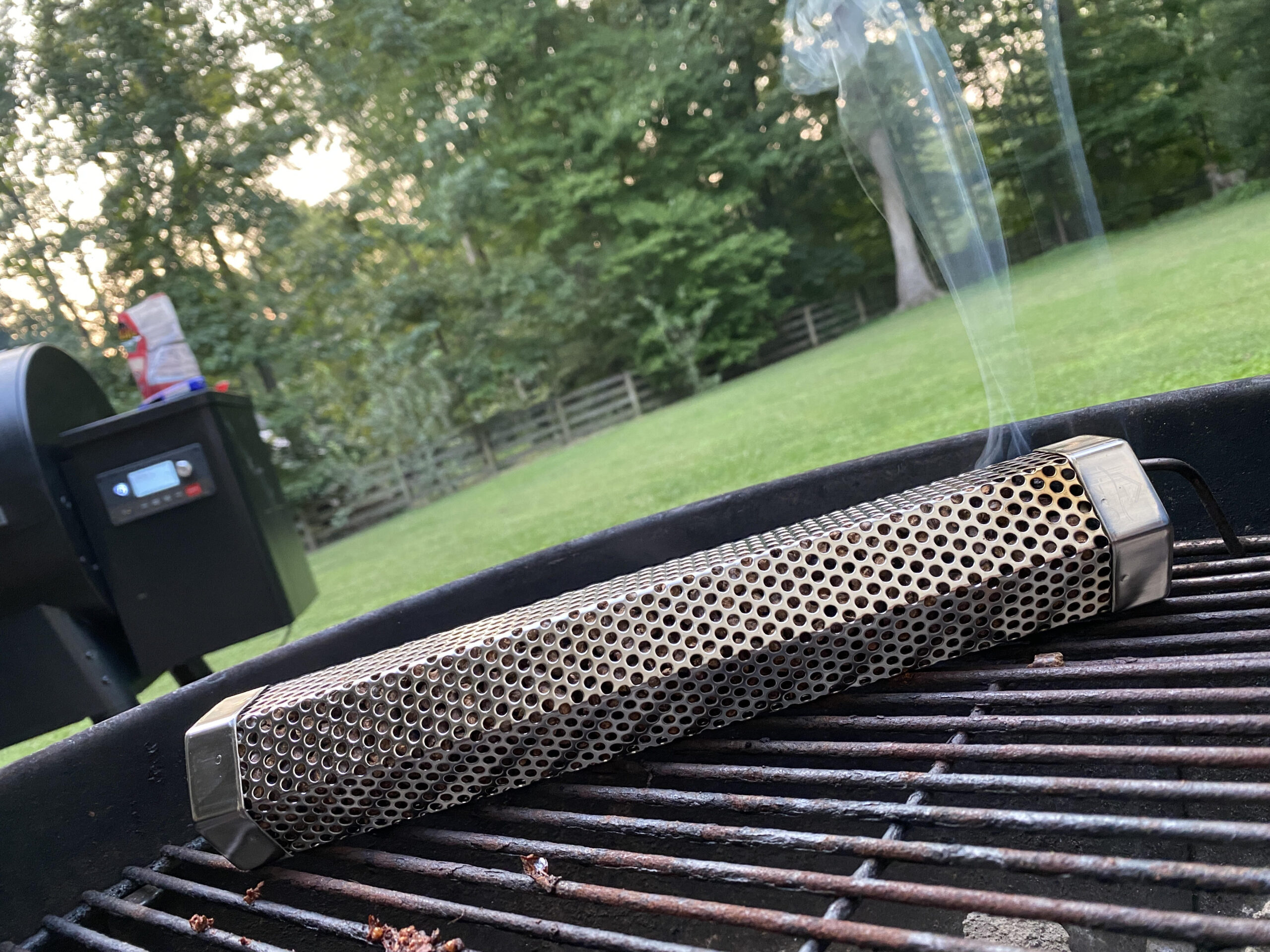
Methodology
For my test of the best wood pellets, I took into account the main concerns users would have when using pellets in their smoker or grill.
- Smoking Time (How long do the pellets last at normal smoking temperatures?)
- Temperature (Do the pellets keep a consistent temperature?)
- Ash Residue (Do the pellets produce a lot of ash?)
- Flavor (Is the smoke flavor clean and pure?)
- Ingredients (Are the pellets free of additives and binders?)
My test unit was the Traeger Ironwood 885 and my charcoal grill using the LZZQ pellet smoker. I tested each pellet in my Trager, both low and slow, and in high-temperature applications, such as grilling or cooking pizza. I carefully watched the smoker temperature, smelled the smoke, and checked the before and after ash residue for each smoking run. For my cold smoking test, I filled my LZZQ, lit it with a propane torch, and monitored that the temperature stayed below 110℉. I also periodically checked to see if the pellets evenly burned in the tube.
Things to Consider Before Buying Wood Pellets
Pellet smokers are more popular than ever, and there are many excellent wood pellets on the market. The question becomes: Which is best for you? Here are some things to consider:
Ingredients
The top thing to consider before buying wood pellets is what they are made from. You want to use pellets made from hardwood and nothing else. If a manufacturer has a list of ingredients that includes anything other than 100 percent hardwood, steer clear.
Type of Wood
Different types of wood produce different smoke flavors and are best suited for different meats. Oak and hickory are excellent all-purpose woods that give a smoky flavor that doesn’t overpower meat. You can use them for chicken, pork, and beef. Fruit woods, like apple, give a mild smoke flavor with a hint of sweetness. They are best for cheese, fish, and chicken where a delicate smoke best compliments the subtle flavors of the meat. Wood such as mesquite produces an intense smoke flavor for those that enjoy bold BBQ flavors.
Bag Size
Most pellet grill hoppers hold 20 pounds of pellets, but some companies make 40-pound bags. The larger bag offers some savings per pound, but you’ll need a storage container for the extra pellets. If you are looking to add smoke flavor to the food you cook on your grill, a handful of smokers in an aluminum tray or in a pellet smoker tube is a great solution. For that application, smaller one-pound bags are more convenient.
FAQs
Questions and answers for buying your next bag of wood pellets.
The best wood pellets are made from sustainably harvested hardwood and contain no additives or binders. Another quality that makes some pellets better than others is the size of the pellet, which contributes to how it feeds in a pellet grill. Some pellet grills feed small pellets well, while others feed large pellets better.
In general, 20 pounds of pellets will last 30 to 40 hours of low and slow smoking. However, how long your 20-pound bag of pellets lasts will depend on the temperature you are cooking, the size of your smoker, and the outside temperature. The higher the temperature of your smoker, the more pellets your smoker will use.
Wood chips are more prone to flaming up and causing temperature spikes than pellets. That’s why pellets are best for smoking in a conventional grill. Wood chips excel in propane smokers or electric offset smokers designed for wood chips rather than pellets.
Outdoor Life Values
Outdoor Life editors don’t just enjoy hunting and fishing as hobbies—the pursuit of these passions make us who we are. Our writers are diehard outdoorsmen and women, too. For more than a century, OL has been evaluating the latest and greatest outdoor gear and providing our readers with no-B.S. reviews. We test products in the field under real-world conditions. We write about the pros and cons of every product we review so that you know exactly what you’re getting if you decide to purchase the gear we cover. Only the best hunting, fishing, backpacking, camping, and survival gear will make the cut in our reviews and roundups. If we’re covering it, you know it’s legit.
